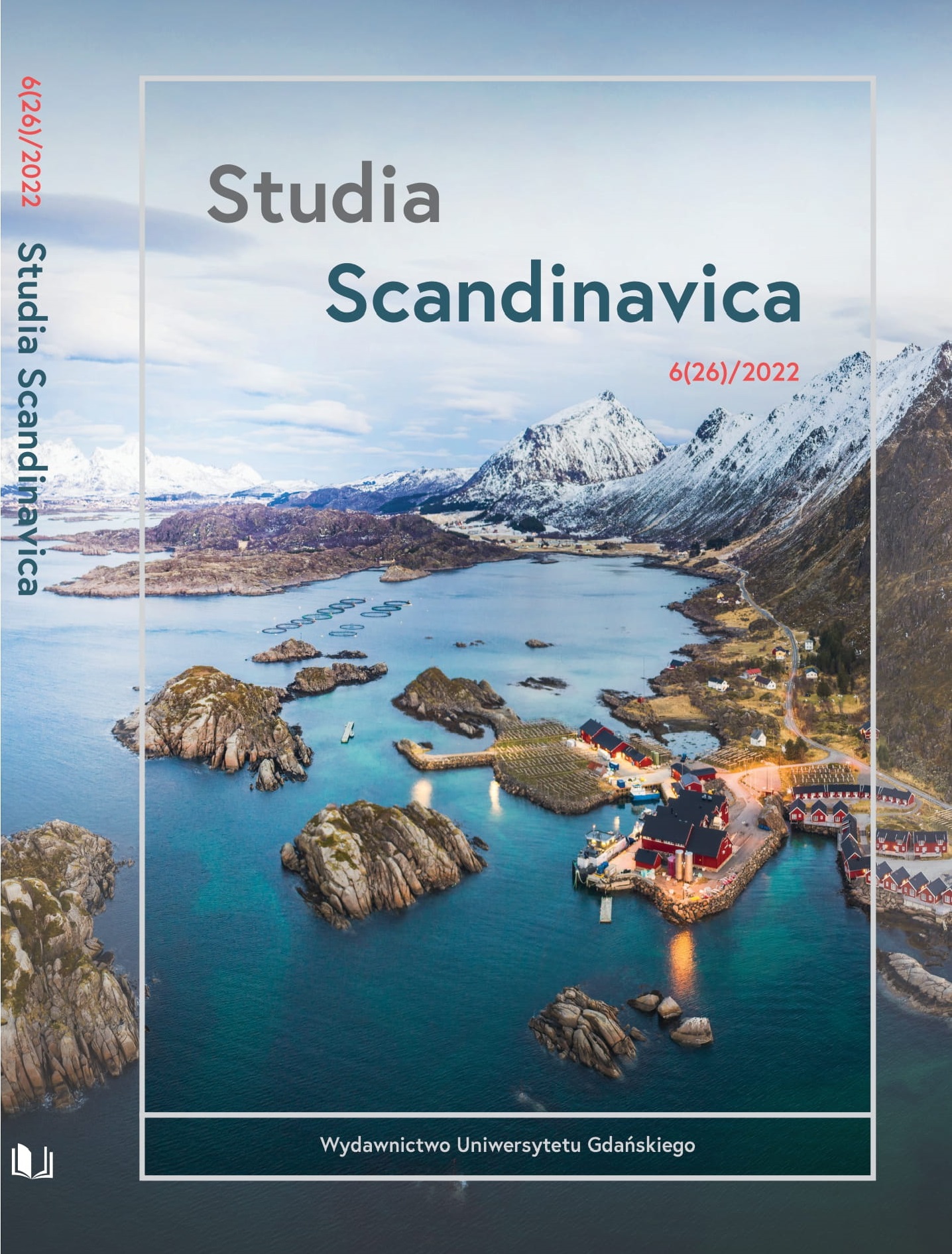Skandynawski „błędny rycerz”, czyli zestawienie Olafa Tryggvasona Odda Snorrasona z Percewalem Chrétiena de Troyesa
DOI:
https://doi.org/10.26881/ss.2022.26.02Słowa kluczowe:
Olaf Tryggvason, Odd Snorrason, Percewal, Chrétien de Troyes, błędny rycerz, literatura nordycka, romans dworskiAbstrakt
In courtly literature, the subject of the Errant Knight appears frequently, such as Eretz, Lancelot, and Perceval. In the Icelandic sagas, we can also meet such figures as. The purpose of this article is to show that the Olaf Tryggvason described by Odder Snorrrson was the Errant Knight as well. The author wants to show it by comparing Olaf Tryggvason with Perceval through their lives and their correlations. The author wants to show it by comparing Olaf Tryggvason and Perceval’s lives. These characters are correlated with each other. This is because Oddr and Chrétien de Troyes have built the plot of their works based on religion and love plots. They wanted to show a character who strives for the ideal through mistakes and learning.
Downloads
Bibliografia
Źródła
Biblia Tysiąclecia (2003). Poznań: Pallottinum.
Bósa saga ok Herrauðs, http://www.germanicmythology.com/FORNALDARSAGAS/BosaSagaHardman.html [dostęp: 10.02.2022].
Brennu-Njáls saga (1954). E.Ó. Sveinsson (ed.). Reykjavík: Hið Íslenzka Fornritafélag XII.
Chrétien de Troyes (1996). Arthurian Romances. D.D.R. Owen (tłum.). London.
Chrétien de Troyes (1968). Percewal z Walii, czyli Opowieść o Gralu. W: Z. Czerny (red.). Arcydzieła francuskiego średniowiecza. A. Tatarkiewicz (tłum.). Warszawa: PIW.
Dzieje Tristana i Izoldy: odtworzone wedle dawnych legend i poematów (2012). Warszawa: Fundacja Nowoczesna Polska.
Lancelot-Grail, The Old French Arthurian Vulgate and post-vulgate in translation (2010). N.J. Lacy (ed.). S.N. Rosenberg, C.W. Carroll (transl.). Cambridge: D.S. Brewer.
Laxdœla saga (1934). V.E. Sveinsson (ed.). Reykjavík: Hið Íslenzka Fornritafélag.
Odd Munk Snorresøns (2006). Olafs saga Tryggvasonar. Þ.I. Guðjónsson (ed.). Reykjavik: Íslenzka Fornritafélag XXV.
Óláfs saga helga (1945). W: B. Aðalbjarnarson (ed.). Heimskringla. Reykjavik: Íslenzka Fornritafélag XXVII.
Pieśni. Parsifal. Titurel (1996). A. Lam (tłum i oprac.). Warszawa: Verum.
Saga o Olafie Świętym (2019). W: Heimskringla. vol. 2: A. Waśko, J. Morawiec (red. i oprac.). Kraków: Księgarnia Akademicka.
The Saga of Bosi and Herraud (2014). W: Six Sagas of Adventure. B. Waggoner (transl.). New Haven: The Troth.
Opracowania
Andersson, Th.M. (2003). The Saga of Olaf Tryggvason: Oddr Snorrason. W: Islandica 52. Ithaca and London: Cornell University Press.
Bandlien, B. (2005). Strategies of Passion, Love and Marriage in Medieval Iceland and Norway. Hull: Brepols Publishers.
Bretèque, F.A. (1995). La figure du chevalier errant dans l’imaginaire cinématographique. Cahiers de l’Association Internationale des Etudes Francaise, vol. 47, nr 1, s. 49–78.
Dybeł, K., Marczuk, B., Prokop, J. (2005). Historia literatury francuskiej. Warszawa: Wydawnictwo Naukowe PWN.
Fidjestøl, Bj. (1982). Det norrøne fyrstediktet. Universitet i Bergen Nordisk institutts skriftserie 11. Øvre Ervik: Alvheim & Eide.
Friðriksðóttir, J.K. (2013). Women in Old Norse Literature. Bodies, Words, and Power. Oxford: Palgrave Macmillan.
Grønlie, S.E. (2017). The Saint and the Saga Hero. Hagiography and Early Icelandic Literature. Cambridge: D. S. Brewer.
Halldórsson, Ó. (2006). Introduction. W: Th. I. Guðjónsson (ed.). Odd Munk Snorresøns. Olafs saga Tryggvasonar. Reykjavik: Íslenzka Fornritafélag XXV.
Jesch, J. (2004). ‘Youth on the Prow’: Three Young Kings in the Late Viking Age. W: P.J.P. Goldberg, F. Riddy (eds.). Youth in the Middle Ages. Woodbridge: Boydell & Brewer, s. 123–140.
Johansson, K.G. (2018). The Learned Sturlungar and the Emergence of Icelandic Literate Culture. W: G. Sveinbjarnardóttir, H. Þorláksson (eds.). Snorri Sturluson and Reykholt. The author and magnate, his life, works and environment at Reykholt. Copenhagen: Museum Tusculanum Press, s. 138–151.
Jónsson, J. (1887). Um klaustrin á Islandi. Þingeyraklaustur. Tímarit hins íslenzka bókmentafélags 8: 182–200.
Kovárová, L. (2011). The Swine in Old Nordic Religion and Worldview. Reykjavík: Félagsvísindasvið Háskóla Íslands.
Lönnroth, L. (1963). Studier i Olaf Tryggvasons saga. Samlaren 84: 54–94.
McGilchrist, M.R. (2012). The Ties that Bind: Intertextual Links between All the Pretty Horses and Sir Gawain and the Green Knight Megan McGilchrist. W: N. Monk (ed.). Intertextual and Interdisciplinary Approaches to Cormac McCarthy: Borders and Crossings. Routledge.
Monaghan, P. (2004). The Encyclopedia of Celtic Mythology and Folklore. New York: Facts On File.
Ólason, V. (1994). The Marvellous North and authorial presence in the Icelandic fornaldarsaga. W: R. Eriksen (ed.). Contexts of Pre-Novel Narrative. vol. 114. Berlin: Mouton de Gruyter.
Sakowska, M. (2006). Portret, postać, autorka. Kobieta a literatura europejskiego średniowiecza. T. I. Warszawa: Neriton.
Tolley, C. (2006). The Historia Norwegiae as a Shamanic Source. W: J. McKinnell, D. Ashurst, D. Kick (eds.). The Fantastic in Old Norse/Icelandic literature. Sagas and the British Isles, vol. 2. Durham–York, s. 951–960.
Waśko, A. (2013). Wstęp. W: Saga o Olafie Tryggvasonie, Oddr Snorrason. A. Waśko (tłum. i oprac.). Kraków: Księgarnia Akademicka.
Wolf, K. (2014). Viking Age. Everyday life during the extraordinary era of the Norsemen. New York: Union Square & Co.
Zumthor, P. (1974). Okres heroiczny (od połowy XI do połowy XII wieku). W: Literatura francuska. T. 1. Warszawa: PWN.

 Uniwersyteckie Czasopisma Naukowe
Uniwersyteckie Czasopisma Naukowe





